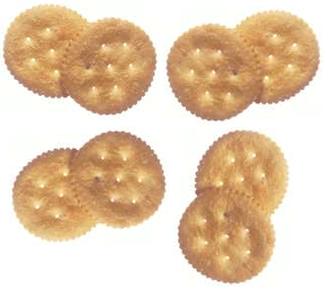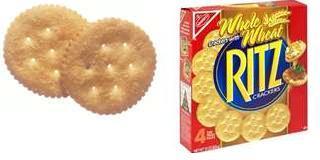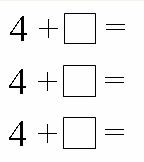Counting-on: a basic counting skill
Posted by: Gary Ernest Davis on: February 9, 2010
5 year old Tim’s dad asked him: “Tim, you can see 8 crackers on the table. How many more would you need to have 13 crackers?â€

As he worked on this problem Tim moved his jaw from side to side 5 times, talking very quietly as he did, and then said: “Five”.
What was Tim doing, and what was he counting?
It seems that Tim counted how many times he moved his jaw as he said “nineâ€, “tenâ€, “elevenâ€, “twelve, “thirteenâ€, and so concluded that 13 is 5 more than 8.
In fact, when his dad asked him Tim said that’s what he did.
Tim can count in a way that many 5 year olds cannot. He does not have to always begin counting from “one”.
Tim is at the very beginning stages of learning how to count-on.
He uses body movements, coordinated with saying a number that does not begin at “oneâ€.
He counts his body movements as he does this. Tim has to focus his attention very carefully and coordinate his speech and his jaw movements.
Tim seems like a child who is counting physical objects except that he counts the movements of his jaw.
But Tim is doing much more than that.  He begins saying part of a number sequence, beginning at “nine’ – the point he would have been at if he had counted from “one†through “eightâ€.
What this tells us is that he can mentally extract a number like “eight†from the sequence of counting numbers and begin his counting from there.
Because Tim can begin saying counting numbers from points other than “one†he is at the beginning of being able to count-on.
Children who can count-on – that is, begin counting from a given number – will usually use this ability to figure out a problem such as “8 + ? = 13â€, much as five year old Tim did.
They will also use counting-on to solve addition problems. For example, a child who can count-on will typically answer a question such as “What is 7 and 4 more?†by counting-on from “sevenâ€: “eightâ€, “nineâ€, “tenâ€, “elevenâ€.
At first, children count-on to solve addition problems by starting from the first number presented to them: for 3 + 7 they will typically begin by counting-on from 3. Only later, as they have mastered this aspect of counting-on, will they begin by counting-on from the larger number (7, in this example.)
Tim, and other children who tap their fingers when they count-on, are focusing mainly on body actions. The children make body actions such as tapping, or biting their lips as they count-on. It may be that they do not have visual or other concrete images in their minds. They may be focusing on keeping in working memory the number of taps or bites they are making.
Whichever is the case – focusing on mental images or on real-time body movements – the thing these children are not doing is taking the number names from one: “one”, “twoâ€, “three†… as things to count or to recite.
Children who count-on have made a huge advance beyond being able to count physical objects, even hidden ones. They are flexible with regard to where their counting begins.
Many teachers and adult helpers believe that all children in the early grades of school should be able to count-on, and for those who cannot, the teacher should show them how it is done, by direct instruction.
For example, a grade one teaching assistant, Marie, was working with a small group of children. These children had been assessed by the teacher as the most needy in the class, on the basis of their counting skills. The task for them was to choose a small number of blocks from a container, and say how much more than 4 the total would be. The children had all been given a work-sheet with numbers and totals to be filled in:
Edward, a 5 year old, reached into the container and picked out 5 blocks.
Marie asked him to write 5 in the first box.
Marie already knew Edward would not be able to count the 5 blocks and 4 more without seeing the other 4, so she asked Edward to take out 4 more blocks. She then asked him how many there were in total.
He bunched all blocks together and counted: “one, two, three, four, five, six, seven, eight, nine.†He then wrote 9 after the equality sign.
Edward repeated the exercise, this time choosing 3 blocks from the container. Again he bunched all the blocks together and counted from 1 through 7, before writing his answer. At that point Marie said to him:
“Edward, you are always counting 4 more than what you choose, so just start from 4.â€
“OKâ€, said Edward.
He reached in the container, and took out 4 blocks. He then took out 4 more, bunched them together, and counted from 1 through 8.
Marie stopped him.
“Edward, did you listen to what I said? You can begin counting from 4. Like this: four, five six, seven, eight.â€
Edward nodded his head, reached into the container and took out 8 blocks. He took out 4 more, bunched them together, and counted from 1 through 12.
Marie shook her head in frustration.
Of course Marie was frustrated. She did not know about children’s developmental counting types, and to her, as an adult, it just made sense to count from 4 when you always had 4 to add to the new number of blocks from the container. All she was doing was showing Edward how to do that.
Sadly, for both Edward and Marie, Edward was not yet able to count-on.
Edward needed work on counting physical objects, and then help progressing to being able to count hidden objects he could not see, such as crackers in a box:

Edward first needs to learn to figure problems like: there are 2 crackers on the table and 4 more in the box. How many are there in all?
No amount of telling, in that class period, was going to help him count-on.
Careful assessment of a child is of the utmost importance if an adult is to help that child progress to more efficient methods of counting. A child’s self-esteem rises when an adult takes interest in what they can do, listens carefully, assesses thoughtfully, and then suggests new things for the child to do, at which they can be successful.
Edward was in a situation where Marie, meaning well, was rapidly lowering Edward’s self-confidence with counting.


February 9, 2010 at 8:19 pm
Awesome post—great explanation of counting on, but what I love best is the discussion of when not to push a child to a more efficient strategy. A child (especially a 5 year old!) should move on to counting on when he/she is ready through conversations with peers, exploration, teacher questioning, and just plain old time. I’d love to share this with teachers at my school :-)